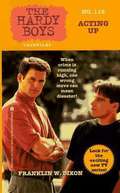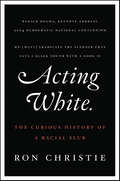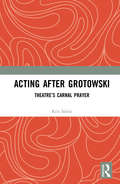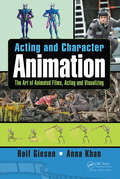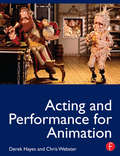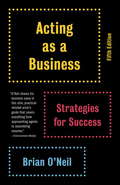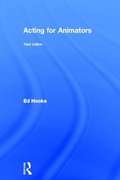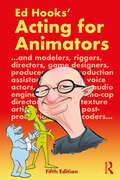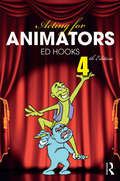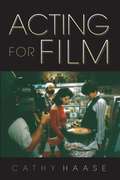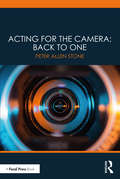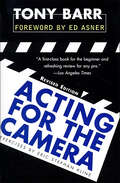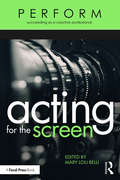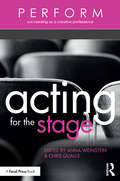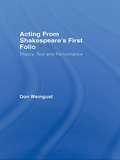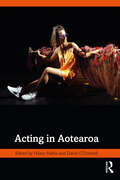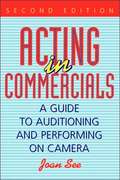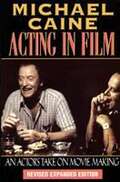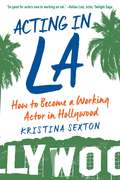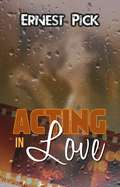- Table View
- List View
Acting Up (Hardy Boys Casefiles #116)
by Franklin W. DixonFrank and Joe have come halfway around the world to investigate sabotage on a movie set. India's culture and customs may be foreign to them, but when it comes to battling terror, neither brother is a stranger to danger. And as soon as they set foot in this land of mystery, it's bombs away over Bombay! Copyright © Libri GmbH. All rights reserved.
Acting White: The Curious History of a Racial Slur
by Ron ChristieIn the tradition of Randall Kennedy's Nigger and Shelby Steele's The Content of Our Character, Acting White demonstrates how the charge that any African-American who is successful, well mannered, or well educated is "acting white," is a slur that continues to haunt blacks. Ron Christie traces the complex history of the phrase, from Uncle Tom's Cabin to the tensions between Martin Luther King, Jr., and Malcolm X to Bill Cosby's controversial NAACP speech in 2004. The author also writes candidly of being challenged by black students for his "acting white," and also of being labeled a race traitor in Congress by daring to be Republican. This lucid chronicle reveals how this prevalent put-down sets back much of the hard-earned progress for all blacks in American society. Deftly argued and determinedly controversial, this book is certain to spur thoughtful discussion for years to come.
Acting after Grotowski: Theatre’s Carnal Prayer
by Kris SalataFor whom does the actor perform? To answer this foundational question of the actor’s art, Grotowski scholar Kris Salata explores acting as a self-revelatory action, introduces Grotowski’s concept of "carnal prayer," and develops an interdisciplinary theory of acting and spectating. Acting after Grotowski: Theatre’s Carnal Prayer attempts to overcome the religious/secular binary by treating "prayer" as a pre-religious, originary deed, and ultimately situates theatre along with ritual in their shared territory of play. Grounded in theatre practice, Salata’s narrative moves through postmodern philosophy, critical theory, theatre, performance, ritual, and religious studies, concluding that the fundamental structure of prayer, which underpins the actor’s deed, can be found in any self-revelatory creative act.
Acting and Being: Explorations in Embodied Performance
by Elizabeth HessIn this book, educator-actor-playwright-director Elizabeth Hess offers systematic and original explorations in performance technique. This hybrid approach is a fusion of physical theater modalities culled from Western practices (Psycho-physical actions, Viewpoints) Eastern practices (Butoh, Kundalini yoga) and related performance disciplines (Mask, Puppetry). Behavioral, physiological and psychological 'states of being' are engaged to unlock impulses, access experience and enlarge the imagination. Through individual, partnered and collective explorations, actors uncover a character's essence and level of consciousness, their energy center and body language, and their archetype and relationship to universal themes. Magic (to pretend, as if), Metaphor (to compare, as like) and Myth (to pattern after, as in) provide the foundation for generating transformative, empathetic and expansive artistic expression. Explorations can be adapted to character work, scene study and production, including original/devised work and established text, to illuminate singular and surprising work through collaborative creativity that is inventive, inclusive and alive.
Acting and Character Animation: The Art of Animated Films, Acting and Visualizing
by Rolf Giesen Anna KhanAnimation has a lot to do with acting. That is, character animation, not the standardized, mechanical process of animation. Acting and animation are highly creative processes. This book is divided into two parts: From film history we learn about the importance of actors and the variety of acting that goes into animation; then, we will turn to the actor's point of view to describe the various techniques involved. Through exhaustive research and interviews with people ranging from the late Ray Harryhausen, Jim Danforth, Joe Letteri, and Bruno Bozzetto, this book will be the primary source for animators and animation actors. Key Features Interviews with industry legends are found throughout this exhaustive work on animation From film history we learn about the importance of actors and the variety of acting that goes into animation, then turn to the actor's point of view to describe the various techniques involved Coverage of acting from Vaudeville to Rotoscoping to Performance Capture Case studies throughout bring the content to life while providing actionable tools and techniques that can be used immediately
Acting and Directing Shakespeare's Comedies: Key Lessons
by Kevin OtosActing and Directing Shakespeare’s Comedies: Key Lessons outlines a clear, effective process for acting Shakespeare’s comedies. This book lays out core principles and useful exercises that help the reader better understand, expereince, and implement Shakespeare's comedic design. Building off of modern acting methods as well as contemporary Clown, classical Commedia, and verse-speaking techniques, the author guides the reader toward interpretive and performance choices that are original, justified, and entertaining. Included are clear examples and detailed case studies that illuminate and reenforce these key lessons. This accessible book is for actors, directors, students of Shakespeare, and those who want a fuller, richer awareness of the possibilities within Shakespeare’s comedies and a clear, pragmatic process for creating those performances.
Acting and Living in Discovery: A Workbook for the Actor
by Carol RosenfeldActing and Living in Discovery, A Workbook for the Actor lays out essential fundamentals of the actor’s process. Based on the author’s experiences at the legendary HB Studio in New York City, Acting and Living in Discovery provides practical guidance for developing, honing, or revitalizing the actor’s craft for the actor. A teacher can use the workbook to support a studio class, a special workshop, part of a university acting course, or private coaching. The chapters delve into basic facets of the acting process that lead the actor into discovering the corporal world of a script. Exercises at the end of each chapter invite the actor to discover the treasure trove of his unique self, and spell out the work an actor can do to wear the shoes of any character. The actor is at once the instrument and the player. The workbook can be read straight through or used as a reference for addressing a particular problem or topic.
Acting and Performance for Animation
by Derek HayesCharacter animation involves more than the principles of animation and the mechanics of motion. Unique, believeable characters that think, feel and captivate your audience are ones that involve emotion, performance, personality, acting and story. Successful animators balance all of these elements within a single character and narrative. With Acting and Performance for Animation, discover how to create dynamic, dramatic performances and believeable character interaction. An invaluable resource for animators, Acting and Performance for Animators is a practical guide to the variety of performance techniques relevant to animators. Develop believable character interactions with chapters detailing the principles of performance, performance types, character emotion and personality, physical and psychological performance, and scene composition. Analyze scripts, sound,acting, action and performance with the practical hints and tips, hands-on assignments and animated examples featured in an extensive guide for animators working in film, TV, games and commercials. Explore different performance techniques based upon the experiences of seasoned animators with case studies featuring John Lasseter, Ray Harryhausen, Nick Park, Joanna Quinn. Expand your own performance techniques with the accompanying DVD which will feature live action reference shorts, production stills, animated examples, and further hands-on assignments.
Acting as Reading: The Place of the Reading Process in the Actor's Work
by David ColeLeft Jacket: "IN A CULTURAL CLIMATE where literary study and theater practice often seem out of touch and out of sympathy with one another, reading and acting tend to be viewed as dissimilar, if not mutually exclusive, occupations. One is private, mental, passive--and something that we all do. The other is public, physical, active--and something that only a few highly trained practitioners do. "David Cole maintains that to act means first of all to make physical the act of reading. But since the act of reading has its origins in bodily activity, Cole contends that in acting, what was once physical becomes physical again. Drawing his evidence from both the history of reading and the major theoretical accounts of the reading process (reader-response, psychoanalytic, poststructuralist), Cole reveals acting to be the recovery of a 'lost' physicality of reading and shows how the principal tasks of an actor can be seen as attempts to recover this lost physicality. "Cole's study examines a variety of reading scenes from plays from the Greek to the postmodern. Finally, it considers the relationship of a dramatic author to actors and audience as essentially that of a writer with 0two different readerships, concluding that the playwright is one who writes the dissemination of reading. Acting as Reading will appeal to scholars, teachers, and students of literary criticism and theory; to actors, directors, and playwrights; and to those in dramatic literature and criticism who seek to root their thinking in the realities of theater practice."
Acting as a Business
by Brian O'NeilAn essential handbook for actors–a modern classic–in a newly updated edition.Since its original publication, Acting as a Business has earned a reputation as an indispensable tool for working and aspiring actors. Avoiding the usual advice about persistence and luck, Brian O’Neil provides clear-cut guidelines that will give actors a solid knowledge of the business behind their art. It’s packed with practical information–on everything from what to say in a cover letter to where to stand when performing in agent’s office–including:•How to craft a winning theatrical résumé•The most effective ways to join the performer’s unions•Tactics for getting an agent•Strategies for finding work in the theater, on daytime television, and in independent films•Navigating the different customs and cultures of New York and Los AngelesO’Neil has updated Acting as a Business to keep up with the latest show-business trends, including how best to use the Internet, making this new edition no actor should be without.
Acting for Animators
by Ed HooksEd Hooks' indispensable acting guidebook for animators has been fully updated and improved! Hooks uses basic acting theory to explain everything from character movement and facial expressions to interaction and scene construction. Just as acting on film and on stage are very different disciplines, so is the use of acting theory in creating an animated character, scene or story. Acting for Animators is full of essential craft tips from an acting master. New to this Routledge edition: - scene-by-scene analyses of six films, including Up, Coraline and Kung Fu Panda - an expanded chapter on video game animation - all-new illustrations - a 500 word history of acting
Acting for Animators
by Ed HooksEd Hooks' essential acting guidebook for animators has been fully revised and updated in this fifth edition, capturing some of the vast changes that have affected the animation industry in recent years. Written specifically for animation professionals instead of stage and movie actors, this book provides an essential primer for creating empathetic and dynamic character performance and, in the process, shows how the strongest storytelling structure works. Hooks applies classical acting theory – from Aristotle to Stanislavsky and beyond – to animation, as well as explaining scene structure, character development and the connections between thinking, emotion and physical action. Theory presented here applies to any and all character animation regardless of style or animation technique. Whether your project is stop-motion, 2D, 3D or a blend of techniques, audiences are audiences are audiences, and they have shown up at the theater or cinema so they can experience and enjoy your story. New to this fifth edition: Four new scene-by-scene acting analyses of animated feature films: Flee, Soul, Porco Rosso and The Triplets of Belleville. A comprehensive and updated section titled "Classroom Notes" which includes a segment on experimental animation, a brief history of acting training for actors and guidance on Motion and Performance Capture technology. Updated online database of Hooks' previous film analyses, all in one place. Acting for Animators is essential reading for all students and teachers of animation courses.
Acting for Animators: 4th Edition
by Ed HooksEd Hooks' essential acting guidebook for animators has been fully revised and updated in this 4th edition. Hooks uses classical acting theory – from Aristotle to Stanislavsky and beyond – to explain everything from character analysis and physical movement to facial expression and scene structure. He speaks directly to animators, instead of stage or screen actors. Acting for Animators is an invaluable primer for beginner animators and a useful reference for experienced pros. New to this fourth edition: - 6 new scene-by-scene acting analyses of animated feature films, including Zootopia and The Little Prince - an annotated analysis of Walt Disney’s famous 1935 memo to Don Graham, regarding how best to train animators - advice to the animator about how best to perform visual references - a chapter on Virtual Reality - an online database of Ed’s previous film analyses, all in one place.
Acting for Film
by Cathy HaaseAspiring film and television actors will discover exercises for relaxing the face to achieve maximum expressiveness; maintaining proper eye focus in front of the camera and conveying the "beats" of a scene, even in the shortest takes. They'll also learn tested techniques for adapting to the styles of different directors; modulating voice and breath for maximum effect; preparing for the first day on the set; enduring multiple takes and on-the-set waiting; and much, much more. For any performer who intends to make a living in front of the camera, Acting for Film is the most authoritative resource!
Acting for Film (Second Edition)
by Cathy Haase Ian McKellen"It will not disappoint . . ." —Ian McKellen, from the ForewordAn Authoritative Training Manual for Film Actors and Teachers “In today's entertainment industry of buff bodies and beautiful faces, it's easy to think that a couple of sit-ups and high cheek bones can create a movie legend,” writes film veteran Cathy Haase. However, she adds, what the actor really must have are “technique, craft, and a depth of self-knowledge.” In Acting for Film, Second Edition, Haase shows actors how to develop all of these, sharing her secrets (developed through years of on-camera work) for creating characters who come alive and who touch the souls of the audience. Readers will learn how to apply theatrical training to film acting and hone a personal approach to rendering a character. Acting for Film, Second Edition, is an essential guide for aspiring performers, acting teachers, and anyone interested in gaining a greater understanding of the craft. This new edition includes: Advice on dealing with new technology including CGI and motion capture Concentration and relaxation exercises that will enhance facial expressiveness Exploration of sense memory techniques for on-camera work Animal exercises and their usages Tips for maintaining proper eye focus in front of the camera and conveying the “beats” of a scene, even in the shortest takes For any performer who intends to make a living in front of the camera, Acting for Film, Second Edition, is the most authoritative resource! With Haase’s experience and advice in their pocket, readers will be prepared to land the film role they’ve been dreaming of.
Acting for the Camera: Back To One
by Peter Allen StoneActing for the Camera: Back to One is a "how to" book with practical steps to achieve a professional performance on camera. The book focuses on four distinct areas: how to prepare the character, how to execute the technical responsibilities that will assist the editor in creating the on-camera performance in post-production, tips from industry professionals, and how to create effective self-tape auditions. Part One: The Character’s World is packed with tools to analyze the script and fully prepare the character before arriving on set. Part Two: The Actor’s World focuses on developing technical acting skills for the camera that assist the pre- and post-production teams to create a dynamic on-screen performance. In Part Three: The Professional World, industry professionals provide tips from inside the film/TV audition room and how to navigate a career in the acting business. The final section, Part Four: Self-Tape Like a Pro, outlines how to build a self-tape studio in the privacy of your own home and submit high-quality self-tape auditions that will help you stand out from the competition. Written for students enrolled in Acting for the Camera courses, Acting for the Camera: Back to One explores techniques that can be practiced and mastered by actors of all levels, from the moment they audition for the part through to when they hear that director call "cut!"
Acting for the Camera: Revised Edition
by Tony BarrLearn how to adapt the craft of acting to the needs of the camera and how to make it in TV & film with this guide full of insights from pros in the field.Culled from Tony Barr’s forty years of experience as a performer, director, and acting teacher in Hollywood, this highly praised handbook provides readers with the practical knowledge they need when performing in front of the camera. This updated edition includes plenty of new exercises for honing on-camera skills; additional chapters on imagination and movement; and fresh material on character development, monologues, visual focus, playing comedy, and working with directors. Inside tips on the studio system and acting guilds make it particularly helpful for people new to the business, and numerous anecdotes from actors such as Morgan Freeman and Anthony Hopkins and examples from current movies illustrate its many lessons. It is perfect for acting classes, workshops, all actors who work in front of the camera—and all those who want to.
Acting for the Screen (PERFORM)
by Mary Lou BelliActing for the Screen is a collection of essays written by and interviews with working actors, producers, directors, casting directors, and acting professors, exploring the business side of screen acting. In this book, over thirty show business professionals dispel myths about the industry and provide practical advice on topics such as how to break into the field, how to develop, nurture, and navigate business relationships, and how to do creative work under pressure. Readers will also learn about the entrepreneurial expectations in relation to the internet and social media, strategies for contending with the emotional highs and lows of acting, and money management while pursuing acting as a profession. Written for undergraduates and graduates studying Acting for Screen, aspiring professional actors, and working actors looking to reinvent themselves, Acting for the Screen provides readers with a wealth of first-hand information that will help them create their own opportunities and pursue a career in show business.
Acting for the Stage (PERFORM)
by Anna Weinstein Chris QuallsActing for the Stage is a highly accessible guide to the business of theater acting, written for those interested in pursuing acting as a profession. This book is a collection of essays by and interviews with talented artists and businesspeople who have built successful careers in the theater; it’s a goldmine of career advice that might take years to find on your own. Herein, the myths around professional acting are dispelled, and the mysteries revealed. Acting for the Stage illuminates practical strategies to help you build a life as a theater professional and find financial rewards and creative fulfillment in the process. Contains essays by and interviews with working stage actors, acting coaches, directors, writers, and agents. Features discussions on selecting a graduate school program, choosing acting classes and workshops, making the most out of your showcase, landing an agent, networking and promoting yourself, and the business of casting. Covers issues of money management, balancing the highs and lows of the profession, finding work to nourish your acting career, and building your creative team and support network.
Acting from Shakespeare's First Folio: Theory, Text and Performance
by Don WeingustActing from Shakespeare's First Folio examines a series of techniques for reading and performing Shakespeare's plays that are based on the texts of the first ‘complete’ volume of Shakespeare's works: the First Folio of 1623. Do extra syllables in a line suggest how it might be played? Can Folio commas reveal character? Don Weingust places this work on Folio performance possibility within current understandings about Shakespearean text, describing ways in which these challenging theories about acting often align quite nicely with the work of the theories' critics. As part of this study, Weingust looks at the work of Patrick Tucker and his London-based Original Shakespeare Company, who have sought to discover the opportunities in using First Folio texts, acting techniques, and what they consider to be original Shakespearean performance methodologies. Weingust argues that their experimental performances at the Globe on Bankside have revealed enhanced possibilities not only for performing Shakespeare, but for theatrical practice in general.
Acting in Aotearoa
by Hilary Halba David O’DonnellThis comprehensive text traces a cultural history of acting practice in Aotearoa/New Zealand, whose Indigenous Māori practitioners have made a significant impact on acting processes, principles and values in this postcolonial nation.Each chapter outlines not only historical aspects of acting in Aotearoa but also the way in which the phenomenon of acting has been modified by contingent local conditions. Interwoven into each chapter is a consideration of cultural, political and historical forces that have influenced the art form of acting in Aotearoa. Chapters include vivid personal accounts from the contributors, all of whom are also professional artists as well as scholarly experts in their fields. Interweaving the chapters are interviews with key practitioners and actors, which provide eloquent, first-hand accounts of current innovative actor training practice.Representing a wide range of approaches to acting and actor training for stage and screen, this book will be of use to scholars, students and theatre practitioners alike.
Acting in Commercials: A Guide to Auditioning and Performing on Camera
by Joan SeeProfessional actors covet opportunities to act in commercials because of the potentially high income and visibility. But commercials require an acting style that is specific to the medium. This updated volume explains how to adapt one's acting skills to the needs of brief and persuasive commercial scripts. 16 illustrations.
Acting in Film: An Actor's Take on Movie Making (Applause Acting)
by Michael CaineA master actor who's appeared in an enormous number of films, starring with everyone from Nicholson to Kermit the Frog, Michael Caine is uniquely qualified to provide his view of making movies. <p><p> This new revised and expanded edition features great photos throughout, with chapters on: Preparation, In Front of the Camera Before You Shoot, The Take, Characters, Directors, On Being a Star, and much more.
Acting in LA: How to Become a Working Actor in Hollywood
by Kristina SextonEach year, hundreds of aspiring and experienced actors head to LA hoping to make it big in Hollywood. While many of them have their acting chops in shape, few realize what it actually takes to survive in Tinseltown. Even if they happen to make it onto a set, many are clueless about what’s expected of them and how they should behave. Acting in LA: How to Become a Working Actor in Hollywood is exactly what these actors need: a handbook to arriving, surviving, and thriving on- and off-set in LA. Written by veteran Hollywood actor, acting coach, and acting teacher Kristina Sexton, this comprehensive guide takes no prisoners. With just enough snark to keep readers entertained—and on their toes—Acting in LA delivers solid advice on such topics as:Headshots, resumes, and reelsHow to find your “image” and market itThe SAG/AFTRA debateNetworkingAgents and managersThe importance of creating your own opportunitiesMaintaining a life outside of actingSetiquetteOn-set terminologyAnd much more A comprehensive guide that can be utilized by actors either inside or outside Hollywood, Acting in LA relies on Kristina’s real-life experience as a working actress and exposes the pleasures, pitfalls, and practicalities of pursuing a career in acting.
Acting in Love
by Ernest PickRoger, a well-known tv actor on the soap Babylon Revisited, meets Denise on vacation in Nassau. Denise manages the dolphin show for the resort, but is, in fact, a frustrated actress. Roger says he will find work for her on TV. The novel flows in three parts: Part One: Keely (played by Denise) has a sister who is murdered in Babylon Revisited in a highly unusual manner. Roger (playing Armand, a private eye) will uncover the murderer whose exceptional use of a dog bearing a virus makes the murder happen. Part Two: Roger (playing Benjamin) and Denise star in a full-length play heading for Broadway called Wars of Independence. Denise plays the role of Marcella, a student at the college where Roger is teaching. They fall in love and after a rather torturous relationship, marry. Marcella cheats on Benjamin. Benjamin, incensed and brooding, plans revenge and finds a way to pay back his unfaithful spouse in a most unusual, brutal manner. Part Three: Roger and Denise have a rocky personal relationship outside of their work. Intimacy is an issue for Roger. Can they succeed despite this impediment?
